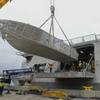The U.S. Navy's Expeditionary Strike Group 7 ships left Brisbane, Australia, on June 10, while amphibious ships of Royal Australian Navy began the embarkation of Australian soldiers in northern neighbor Townsville, launching the force integration training (FIT) phase of Talisman Saber 2007 (TS07).
TS07 is a joint and combined exercise demonstrating and improving on the U.S.-Australian military alliance that will feature crisis action planning and the execution of contingency response operations in land, sea and air maneuvers.
More than 20,000 U.S. and 12,000 Australian personnel will participate in the military training exercise set to enhance interoperability and regional stability.
"This exercise is a prime example of the chief of Naval Operation's vision for a 1,000-ship Navy," said Rear Adm. Carol M. Pottenger, Commander Amphibious Force, 7th Fleet, and Deputy Commander Combined Force Maritime Component Command. "We are excited to work side by side with our Australian friends, developing seamless interplay where we will train as a joint task force and operations staff in crisis action planning for executing contingency operations."
For the U.S. Navy, Expeditionary Strike Group (ESG) 7 assets include the Sasebo, Japan-based ships USS Essex (LHD 2), USS Juneau (LPD 10) and USS Tortuga (LSD 46) with attached escorts from San Diego, USS Paul Hamilton (DDG 60) and USS John Paul Jones (DDG 53). USS Blue Ridge (LCC 19), 7th Fleet flagship, will be operating in the area but independent of the strike group training. Embarked aboard the ESG ships is the 31st Marine Expeditionary Unit (MEU).
Pottenger, along with members of her staff, embarked Essex for Talisman Saber to test interoperability and refine procedures and doctrine of assigned forces afloat, with Amphibious Squadron 11, ESG 7 and Australian counterparts.
Commander Australian Amphibious Task Group Capt. Peter G. Laver believes the field training will help bring the two nations closer, and not only on a military level.
"This exercise reinforces the good will between our two navies and our two nations," said Laver. "We are confident that this exercise will build a common understanding of tactics and capabilities and foster relationships between the sailors, soldiers and airman involved. In the end, the accomplished objectives should lead toward the concept of a 1,000-ship navy in that we are all working together to sustain regional peace and stability."
TS07, a biannual exercise, officially began May 24 with a command post exercise involving U.S. military and Australian military staff members in a computer-simulated U.N. peace keeping operation.
The FIT phase of TS07 will provide a number of opportunities for the two forces to familiarize themselves with each other's capabilities and operational procedures. Day one featured integrated communications and establishing a combined tactical picture. In the following days, the naval and aerial assets of both navies will conduct live-fire training, deck-landing qualifications and combined ship maneuvers, also to include a bilateral refueling at sea.
Aerial assets of the U.S. Navy's expeditionary strike group will be supplied by Marine Medium Helicopter 265 (reinforced) of the 31st MEU.
The integration phase will also feature combined planning by U.S. and Australian forces to complete an amphibious landing and further exercise objectives.
At the conclusion of FIT, the field-training exercise portion of TS07 will commence, sending 31st MEU Marines ashore along with their Australian army counterparts. Pottenger and members of her staff will also disembark Essex at that time to join a combined staff ground headquarters.
"The potential for improving U.S.-Australian relations and combined military capabilities is incredible," said Pottenger. "I am fully confident that the personnel of both our forces will rise to the challenges and make lasting friendships along the way."
Commander, ESG 7 and Task Force 76, the Navy's only forward-deployed amphibious force. Task Force 76 is headquartered at White Beach Naval Facility in Okinawa, Japan, with an operating detachment in Sasebo, Japan.By Mass Communication Specialist 2nd Class (SW) Adam R. Cole, Task Force 76 Public Affairs
Subscribe for
Maritime Reporter E-News
Maritime Reporter E-News is the maritime industry's largest circulation and most authoritative ENews Service, delivered to your Email five times per week










